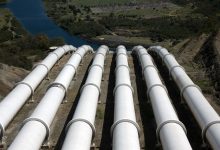The Morrison government’s flagship Snowy 2.0 project has passed a crucial milestone, with a new tunnel segment factory receiving the greenlight from NSW planning authorities, just as yet more environmental and energy experts voice concern about the viability of the massive project.
The NSW planning department said on Sunday it has granted approval for the Snowy 2.0 tunnel segment factory, which will be established in Cooma, after consideration of the project’s environmental impact statement. This is despite environmental groups raising concerns about the impact the Snowy 2.0 project will have on the Kosciuszko National Park.
The new factory in Cooma that will manufacture concrete segments that will provide the lining for up to 27 kilometres of new tunnels created as part of an expansion of Snowy Hydro’s pumped hydro energy storage capacity. The $55 million factory is expected to produced more than 130,000 concrete segments over the course of its three to four years of operation, and employ 125 people.
Snowy Hydro CEO Paul Broad welcomed the approval of the segment factory, saying that it was a positive step forward for the company and the Snowy 2.0 project, after a tough period for the company.
“2020 has been an extraordinarily difficult year for Australia, particularly the local area. First we had the devastating bushfires and now COVID19,” Broad said.
“At times like this we need to continue to drive jobs and investment. That is why we have been so determined to ensure Snowy 2.0 continues full steam ahead. Today’s announcement that we are starting construction on the Polo Flat segment factory is just another piece of the puzzle.”

However, the approval of the segment factory has raised fears amongst environmental groups that it may indicate the approval for the larger Snowy 2.0 project is a mere inevitability.
The Snowy 2.0 project will expand the capacity of the Snowy Hydroelectric scheme by up to 2,000MW, with 175 hours of storage by linking the Talbingo and Tantangara dams through an expanded network of underground tunnels.
A group of 26 environmental groups and experts issued a joint open letter to NSW planning minister Rob Stokes and NSW minister for energy and environment Matt Kean, calling for the Snowy 2.0 project to be halted, saying that the damage it would cause to the Kosciuszko National Park would be unacceptable.
“The destruction that would result from Snowy 2.0 cannot be mitigated to any meaningful extent. No biodiversity offset arrangement or payment could in any way compensate for such impairment to this irreplaceable environment,” the joint letter says.
“It would be tragic if Snowy 2.0 were to proceed, especially when there are better energy storage alternatives. At stake are vast areas of Kosciuszko National Park, the survival of many native species, tens of millions of tonnes of emissions and billions of dollars of Australian taxpayers’ money.”
The letter was co-signed by the National Parks Association of NSW, the Nature Conservation Council, the Total Environment Centre and the National Trust, amongst others.
The National Parks Association of NSW has questioned the accuracy of the purported costs and benefits of the project, saying that the benefits have been overblown and the costs underestimated. This prompted a direct response from Snowy Hydro, which said that the project stacked up both economically and environmentally.
The National Parks Association of NSW has raised concerns about the levels excavation required to establish the Snowy 2.0 project, as well as the impact on local ecological systems and threatened species. The group has argued that the amount of useable energy storage that will be created by the Snowy 2.0 project has been overplayed, and the costs underestimated.
The construction contract for the Snowy 2.0 project has been valued at $5.1 billion, but there are concerns that the project could cost as much as twice that figure, particularly when new transmission network infrastructure is included.
The environmental group led earlier calls from around 30 energy industry experts for the Snowy 2.0 project to be referred to an independent review, before the final approval for the project is granted. In particular, the National Parks Association have called for alternative pumped hydro energy storage projects to be considered, that would not impose on the Kosciuszko national park.
“This development would likely trigger the extinction of a critically endangered species, the Stocky Galaxias, and place several other threatened species at peril. The unique habitats of the alpine zone were particularly hard hit by the terrible fires of last summer, yet Snowy Hydro propose clearing hundreds of hectares of irreplaceable threatened species habitat”.
“What would make approval even more tragic is that there are better energy storage alternatives to Snowy 2.0,” executive officer of the National Parks Association of NSW Gary Dunnett said.
The NSW planning department is continuing its assessment of the larger works plan for the Snowy 2.0 project, as plans for new transmission network infrastructure that will be necessary to deliver additional generation capacity to the rest of the grid.
Decisions on the outstanding assessments for the Snowy 2.0 project are expected to be issued soon. The NSW government has begun fast-tracking the planning approval process to provide a stimulus boost to the state’s construction industry in the context of Covid-19.
RenewEconomy and its sister sites One Step Off The Grid and The Driven will continue to publish throughout the Covid-19 crisis, posting good news about technology and project development, and holding government, regulators and business to account. But as the conference market evaporates, and some advertisers pull in their budgets, readers can help by making a voluntary donation here to help ensure we can continue to offer the service free of charge and to as wide an audience as possible. Thankyou for your support.










